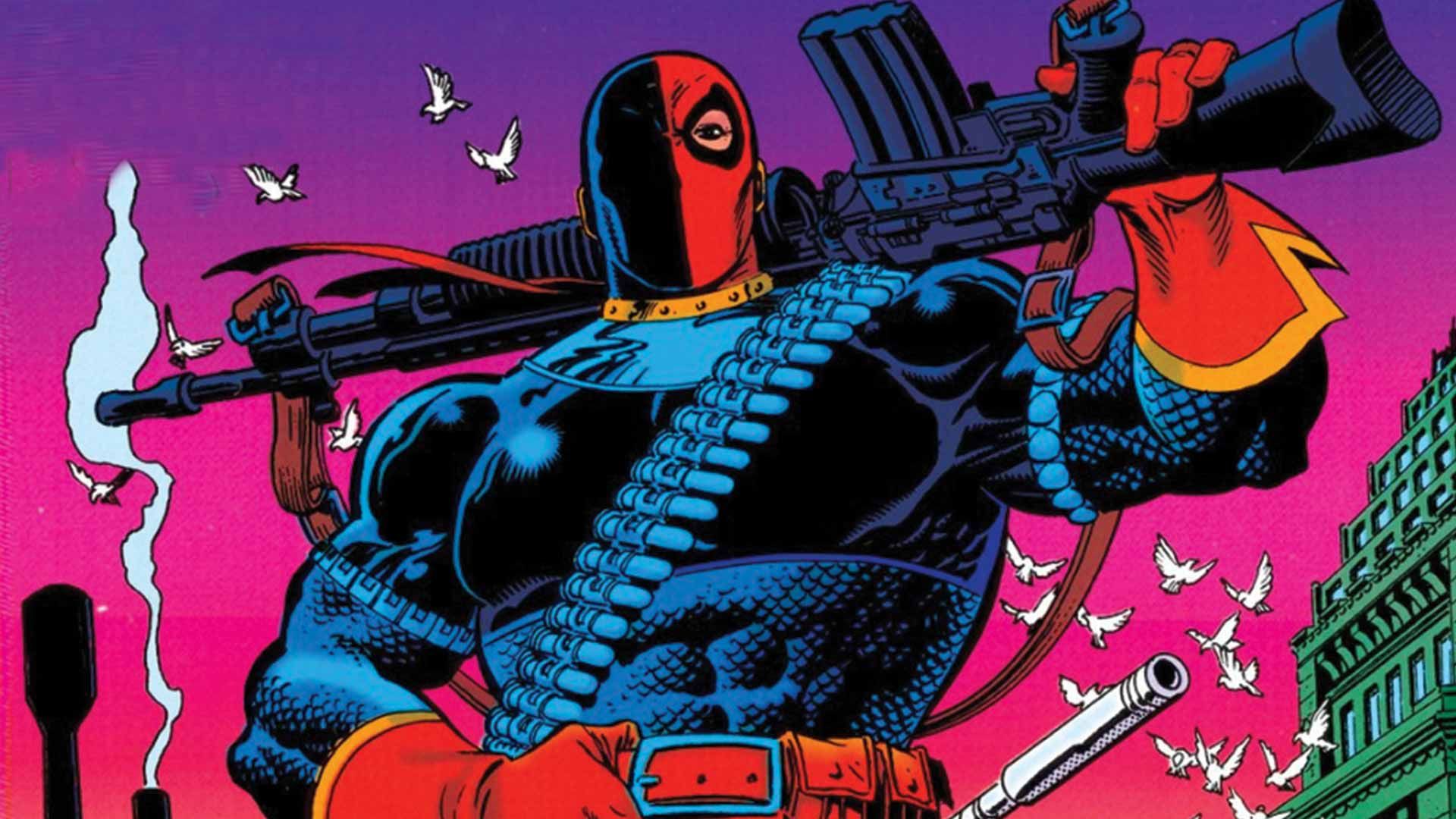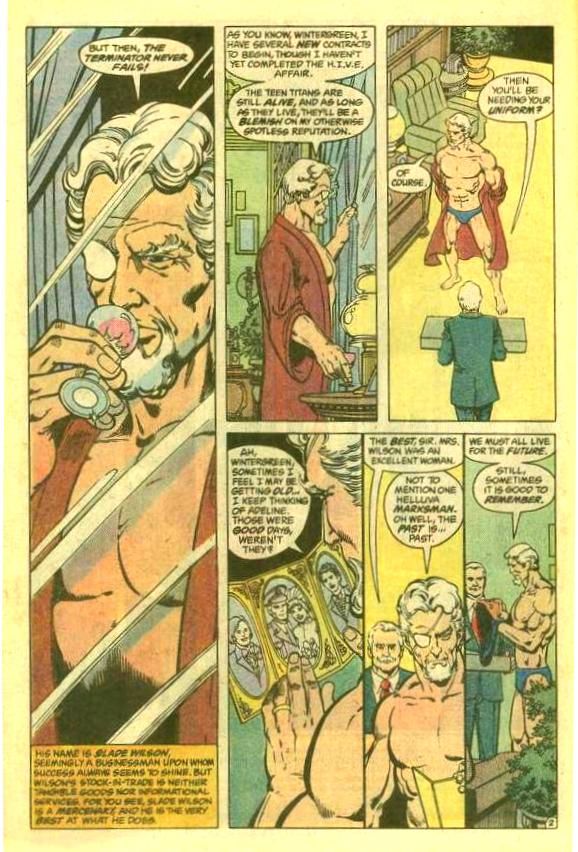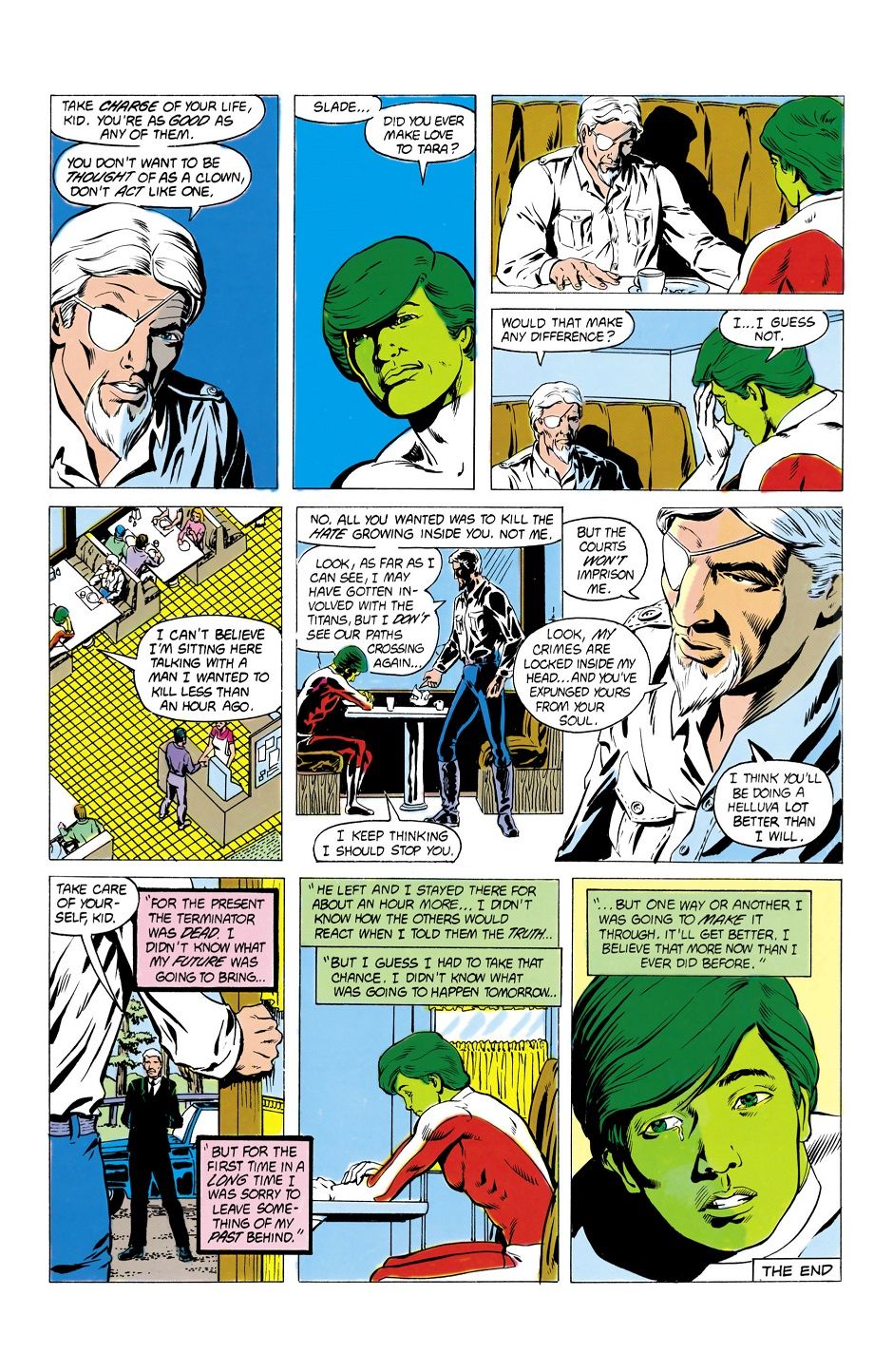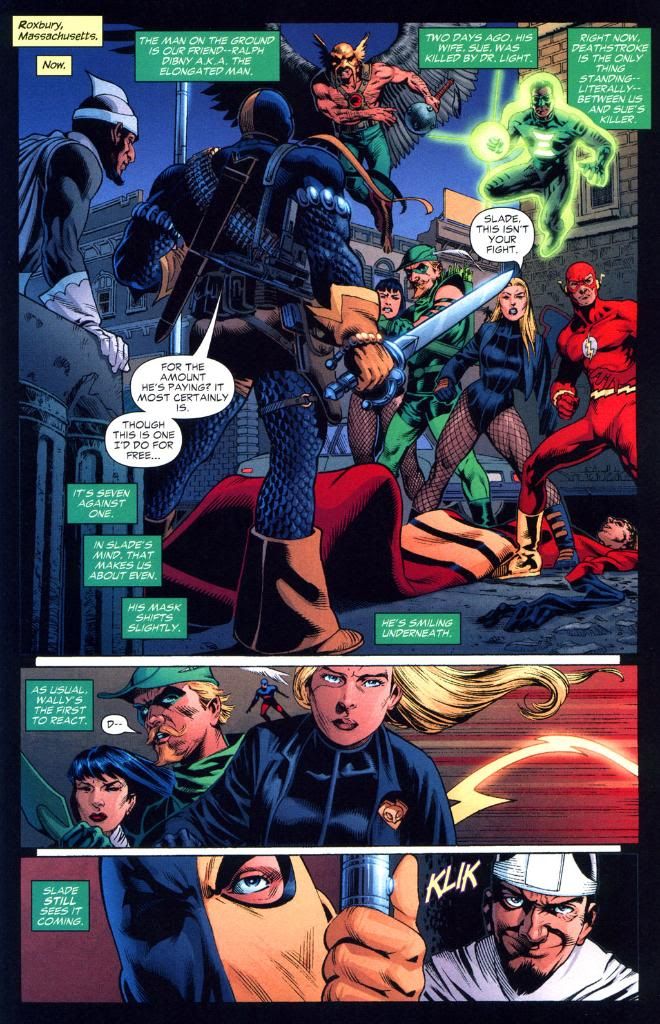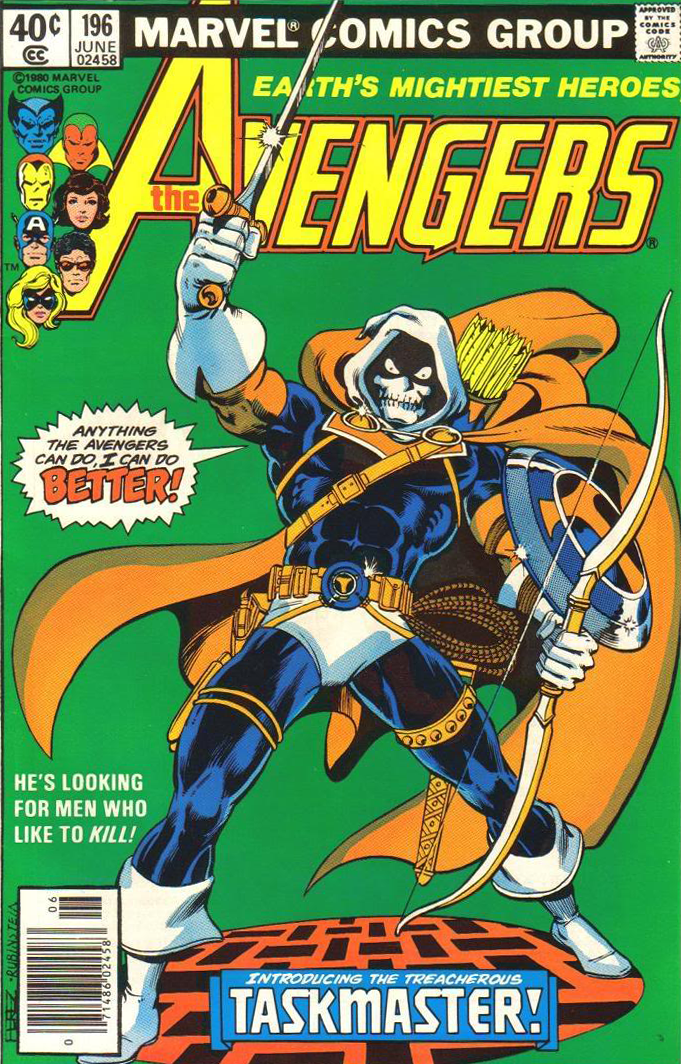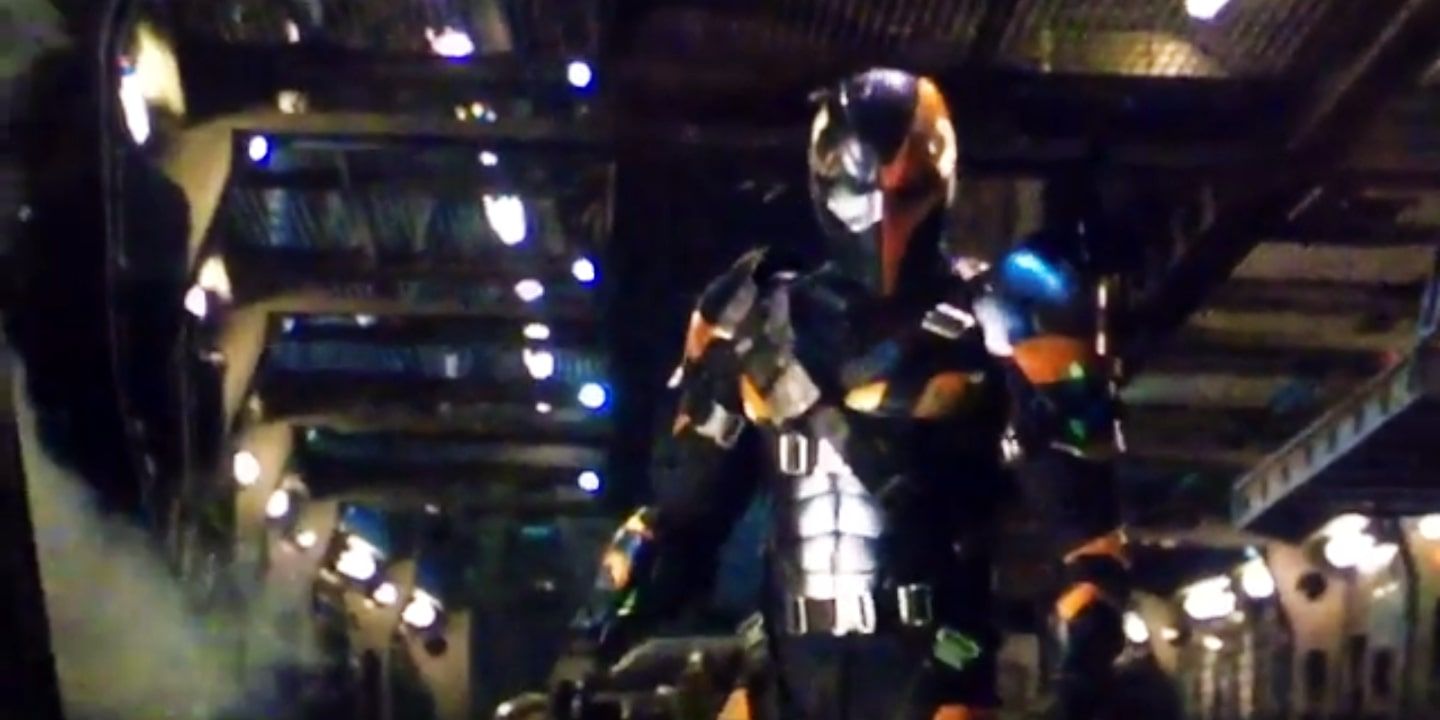Ben Affleck surprised this week with footage of a movie version Deathstroke the Terminator, who may appear in Zack Snyder's "Justice League" before antagonizing the Dark Knight his next solo movie.
There's been a decent amount of Deathstroke outside of comics, most prominently on the "Arrow" TV series. He's been around for 36 years, and has had a few fairly successful solo series. However, as it seems like he only moved into the A-list somewhat recently, today we'll look back to see what prepared him for the big time.
Created by Marv Wolfman and George Pérez, Deathstroke the Terminator (aka Slade Wilson) debuted in December 1980's "New Teen Titans" #2. When readers were introduced to him he was already well-known among the criminal elite, which is why The H.I.V.E. (Hierarchy of International Vengeance & Extermination) hired him to destroy the Titans. Having no beef with the team, he refused and returned to a life of quiet contemplation. The end ...?
Clearly not. Dissatisfied with Deathstroke's refusal, the H.I.V.E. reached out to his son Grant, who actually did resent the Titans, however irrationally, for wrecking his life. (Their battle with Gordanian slavers in the first issue went right through his apartment, but things were bad before that.) The H.I.V.E. scientists gave Grant heightened abilities, which -- to make a long story short -- ended up killing him when he overextended himself in battle. Realizing what could go wrong, Deathstroke was there when Grant died, and agreed to finish what Grant had started. It turns out that's what the H.I.V.E. had planned all along.
Accordingly, even though he asks the H.I.V.E. on the very first page of "New Teen Titans" #2 who they want him to kill, Deathstroke comes across almost as a reluctant villain. He has a personal code, he's avenging his misguided child, and he wouldn't be after the Titans at all except for some bad luck.
From then until his star turn in 1984's landmark "The Judas Contract" (issues 42-44 and Annual #3), Deathstroke appeared only a couple of more times, on the last page of Issue 9 and in issues 10 and 34. (He was also in Chris Claremont and Walt Simonson's out-of-continuity "X-Men Vs. New Teen Titans.") Naturally, each was part of the mercenary's ongoing quest to fulfill his son's contract. In Issue 10 he tried to replicate the trap that killed the Doom Patrol, asking the Titans to trade their lives for that of Cyborg's platonic girlfriend; and in Issue 34 he staged a fight with Terra as part of their strategy to gain the Titans' trust.
Of course, Terra forced Deathstroke to share the villainous spotlight in "The Judas Contract," even though that storyline devoted a big chunk of Issue 44 to his origin. (Short version: He was an Army officer who received a super-soldier serum, and he figured out he could make more money selling his services to the highest bidder.) Afterward, Deathstroke was jailed and eventually put on trial; but thanks to Changeling's behind-the-scenes maneuvering he went free.
It wasn't an act of mercy. Changeling wanted Deathstroke out of prison so he could kill the mercenary himself. Not only had Deathstroke apparently corrupted the girl he loved (therefore contributing greatly to her death), as an ex-Doom Patroller, Changeling was particularly stung by Deathstroke's plan in Issue 10. Moreover, a blast from the mercenary in that issue had pretty much killed Changeling, who then needed the Amazons' Purple Healing Ray to recover. The two eventually reconciled a year later in July 1985's Issue 55, after Slade showed up to their duel unarmed and in street clothes. Changeling couldn't bring himself to kill Slade, so they went to a local diner, talked out their feelings over the course of five pages, and went their separate ways.
There's a case to be made that Wolfman and Pérez (and subsequent artists) could have ended "New Teen Titans" not long after that, because by then they had brought closure to a lot of characters and subplots. Issue 55 (written by Wolfman with art by Ron Randall) certainly worked as an effective coda not just to "The Judas Contract" but to Deathstroke's arc generally. His duties to The H.I.V.E. (and to his son) had been discharged, he'd managed to avoid prison, and his own experience with Terra was enough to put him off being a mercenary for a while. His internal narration even says "[f]or the present the Terminator was dead [and] I didn't know what my future was going to bring."
Indeed, apart from a couple of perfunctory appearances in "Crisis on Infinite Earths" and a small part in 1987's "New Teen Titans Annual," for the most part Deathstroke stayed retired. In a four-issue 1990 arc ("New Titans" #62-65) he returned to help the Titans defeat a cult of were-creatures; and shortly thereafter he got Issue 70 all to himself. Written by Wolfman and drawn by Steve Erwin and Will Blyberg, this issue ostensibly tested the waters for a "Deathstroke" ongoing series by the same team. Regardless, according to editor Jonathan Peterson (as quoted on TitansTower.com) the new book was a done deal:
“Issue 70 came out and was a hit. And to [Executive Editor Dick Giordano's] credit, we actually greenlit 'Deathstroke' behind the scenes before the book even shipped. In fact, I recall going into Dick's office with only the first 12 pages [of issue #70] and saying 'This is what it is … this is what it’ll look like … please let me do this.' And Dick, who trusted my judgment, said 'Okay. Looks good to me. Go for it.'
“So since I was so high on Deathstroke and pushing him, and was looking to give him his own book, I then turned to Marv and said 'Look, you’re going to be writing this new monthly about the guy … clearly he’s popular … so let’s use him to a core degree in the Titans revamp story as well. In short, let’s cram him down the readers throats to really get the character out there again.”
Nevertheless, the solo "Deathstroke" series didn't happen right away. The character appeared in the infamous "Titans Hunt" storyline (issues 71-84), which shook up the book's status quo for good. Essentially Deathstroke teamed up with Nightwing to track down the rest of the team, which had been kidnapped and scattered by a secret society. (Not that Secret Society.) The first issue of the "Deathstroke" ongoing was cover-dated August 1991, and came out in the same month as "New Titans" #78, at about the midpoint of "Titans Hunt."
"Deathstroke" ran for five years, accounting for 60 monthly issues and four annuals. Soon after the series launched, the character started popping up throughout the DC Universe. In 1992 he guest-starred in "Wonder Woman" and the Superman titles and was featured in the "Eclipso: The Darkness Within" crossover. In 1993 he was in a couple of issues of "Green Lantern," the obscure "Chain Gang War" miniseries and an arc in the "Showcase" anthology; and in 1994 he was in a couple of issues of "Green Arrow." Later that year, when he was framed for murder, the book shifted its focus and became "Deathstroke: The Hunted," but that lasted only eight issues. After "Deathstroke" ended in 1996, the guest-shots continued over the next several years, mostly in various Titans titles and Bat-books (including "Birds of Prey").
I don't mean to downplay the existence of the first "Deathstroke" solo series. Five years in any comics market is significant, and "Deathstroke" found an audience both during and after the speculator boom. It's also worth noting that those five years were also the period of "New Titans'" greatest upheaval -- including at least two major makeovers -- culminating in that series' own end.
Accordingly, while Deathstroke was making all those guest appearances in the late '90s and early 2000s, the Titans were reinventing themselves. First it was Dan Jurgens and George Pérez's all-new, short-lived "Teen Titans" (1996-98); then Peter David and Todd Nauck's "Young Justice" (1998-2003) and the adjectiveless "Titans," which reunited the original Silver Age sidekicks (1999-2003); and finally, Geoff Johns and Mike McKone's "Teen Titans," which debuted in 2003 as a combination of its two predecessors.
Not surprisingly, Deathstroke appeared early on in the Johns/McKone "Titans," mainly to break Kid Flash's leg and force the former Impulse into some super-speed book-learnin' while he recuperated. Deathstroke went on to fight a group of Justice Leaguers in 2004's "Identity Crisis," written by Brad Meltzer and penciled by Rags Morales. Fans may quibble with the fight mechanics (Deathstroke took care of The Flash and Green Lantern fairly easily), but it helped to re-establish the character both as a villain and as a combatant. It was a bit of hypercompetence on par with his earlier "Titans" appearance, but on a significantly larger scale. "Identity Crisis" not only helped put Deathstroke back in the spotlight, it re-established him as one of DC's more capable villains.
More importantly, although DC didn't promote it as such, "Identity Crisis" set the stage for the next six years' worth of crossovers. One of its immediate sequels was the "Villains United" miniseries, which gave Deathstroke a leadership role in the newly minted Secret Society of Super-Villains. He lived up to that billing in the subsequent "Infinite Crisis" miniseries, confirming his malevolent bona fides by running Phantom Lady through with his sword.
Meanwhile, in the sanitized form of just plain "Slade," Deathstroke was menacing Cartoon Network's Teen Titans on their eponymous animated series (2003-06). The Slade of "Teen Titans" was a mysterious mastermind and more of an all-purpose bad guy, but as voiced by Ron Perlman, he was one scary dude. His dark portrayal was a counterweight to the series' more outlandish stylistic choices. I doubt it influenced Deathstroke's role in the comics, but it was definitely different from Wolfman and Pérez's original cultured killer.
From there Deathstroke appeared frequently in "Green Arrow" 10 times in 2006-07's issues 60-75, and then headlined the revamped, villains-centric "Titans" in 2010-11. After that his solo series became a mainstay of the New 52, and it's currently a highlight of "Rebirth." Of course, his frequent appearances on "Arrow" (played by Manu Bennett) helped bring Deathstroke to a much wider audience. "Arrow" changed some of the details -- the Australian Slade Wilson was an ex-secret agent who taught Oliver Queen fighting and archery, and gained super-strength from a formula concocted by Professor Ivo -- and emphasized Deathstroke's power and ruthlessness more than the tragedies of his past.
Cumulatively, all these stories cast Deathstroke as one of DC's deadliest characters: a fearsome opponent who could kill you with everything from bare hands to bladed weapons and firearms. In "New Teen Titans" he fought superheroes comparable to Batman, Wonder Woman and The Flash, plus a shape-shifter, energy-projector, magic-user and armored arsenal. (He also learned their secret identities, which led many fans to believe he also knew the secrets of their mentors.) He's not quite an anti-Batman, but given his military-experiment origins he's a sort of anti-Captain America, and that's pretty close.
Having a classic George Pérez design certainly doesn't hurt. The asymmetrical, two-tone costume has just enough detail to look functional, but not complicated. It's almost difficult to imagine that Deathstroke first appeared in 1980, because the costume seemed right at home among the more stylized looks of the early '90s. If there was anything on the stands back then that looked remotely similar, it might have been the Taskmaster, an Avengers villain who debuted a few months ahead of Deathstroke -- and who was also designed by Pérez.
Under the one-eyed mask, Slade Wilson is just as striking. TitansTower.com quotes Pérez as saying he's "my favorite of the Titans’ villains, because I really liked the idea of the strong, massive-yet-debonair older man. The fact that he’s definitely a man in his fifties, but he’s strong as an ox, very handsome, very polished – you can understand, again, a sexual appeal." Like Deadshot's pencil-thin mustache, Slade's eyepatch, white hair and well-trimmed beard were so much a part of the character's look that Deathstroke's action figure came with an unmasked variant.
Deathstroke isn't as blunt as the Punisher or as jaded as Deadshot. Instead, there's more of an intellectual, even cerebral component to his methods. When "The Judas Contract" got rolling he used subterfuge to take out the most powerful Titans: rigged packages to stun Starfire and Cyborg, drugged envelopes for Changeling and a set of sleep-inducing chemicals in Wonder Girl's photo lab. Terra chose to attack Raven directly, and Deathstroke's only face-to-face confrontation was with Dick "Not Yet Nightwing" Grayson.
Being more than just a bruiser or sniper distinguishes Deathstroke from other super-assassins. Bane had a complicated and even sympathetic backstory both in the comics and on film, but ultimately he was more of a bogeyman to be confronted than a foe to be out-thought. To me, the live-action character closest to the comics' Deathstroke may well be Will Smith's Deadshot from "Suicide Squad." He kills people for money and he's not really a good person, but he's not entirely bad either. It's an effective template for a character who can switch sides as the situation warrants.
There's also the sense that Deathstroke hasn't been overexposed. During the two years between his appearances in "New Teen Titans" issues 10 and 34, Wolfman and Pérez introduced a number of signature Titans villains, including the New Brotherhood of Evil, Brother Blood and Starfire's sister Blackfire. They sent the Titans to Mount Olympus and into space, got Donna Troy engaged and expanded the book's supporting cast. They didn't need Deathstroke, so they could use him more strategically.
I'm not sure DC has used Deathstroke "strategically," but compared to other characters he has been used judiciously. It's odd to say about a character who had his own book for five years in the '90s, and who's about to celebrate another five years (more or less) with his own series. Deathstroke has a lot of marketable qualities: He's violent but principled, loaded with weaponry, isn't shy about his dark side and got his eye shot out by his ex-wife. Again, except for the eye and the ex-wife, you could say the same about Batman. If Deathstroke really is going to be a big part of the next solo Batman movie, he'll make a good match for the World's Greatest Detective.
Ironically, that might mean sanding down some of his harder edges. Except for "Teen Titans," DC and Warner Bros. haven't really had to make Deathstroke kid-friendly. (In theory the comics were always kid-friendly, but you know what I mean.) Regardless of content, the Batman and Superman movies have always had to take kids' marketing into account, and as "Teen Titans" demonstrated, Deathstroke needs a little work before he can be marketed to kids. I suspect that's part of the character's appeal as well: Among all of Wolfman and Pérez's New Teen Titans villains, he was the closest thing to a mature adult. We can therefore add a sense of cool detachment to the list of Deathstroke's marketable qualities, because at the end of the day being an assassin is just another job.
All this has made me curious to see how DC and Warners present the character going forward. For decades Deathstroke has been a sort of "hidden gem" or "best-kept secret" among DC's super-people. Will the movies preserve his particular set of nuances, or will he become just another mercenary who's competent enough to give Batman fits for a couple of hours? Maybe Lex Luthor should have set up "Batman v. Deathstroke" and saved himself some trouble.
In any event, Deathstroke should complement Batman pretty well. Being the villain of a Bat-movie is about as big a deal as there is in superhero cinema, and after 30-odd years of dues-paying, Deathstroke seems up to the challenge.

